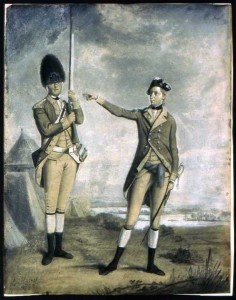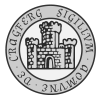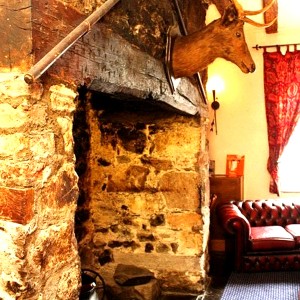There are numerous reports of hauntings in Carrickfergus – not surprising for a town with more than 800 years of history under its belt, including bloody battles, great fires and drawn-out sieges. While not strictly historical, stories of Carrick’s ghosts often still have some basis in reality. Here are a few such hauntings:
Carrickfergus Castle

Arguably Carrick’s most famous ghost is that of a soldier known now by the nickname “Buttoncap”. In reality the soldier in this legend was likely to have been a man by the name of Timothy Lavery, a drummer for the Army regiment stationed in the castle.
During the 1760s, Carrickfergus was garrisoned by the 62nd (Wiltshire) Regiment of Foot, who arrived in late 1759 or early 1760. As the story goes, a young English soldier called Robert Rainey – likely of this regiment – fell in love with a local girl by the name of Betsy Baird. Rainey, who had a reputation as a bit of a rogue, promised Betsy that he would change his ways if she agreed to marry him, which she eventually did.
Unbeknown to Rainey, Betsy had also begun a second secret relationship with the brother of his commanding officer, Lieutenant Colonel John Jennings (who was possibly also an officer). Rainey inevitably discovered the the infidelities of his fiancée and, when encountering Jennings brother in town one day, ran him through with his sword in a fit of rage. He sheathed his sword and calmly returned to his quarters.
Before dying, the victim was able to recount to Jennings what had occurred, but in doing so accused another soldier Timothy Lavery, who bore a striking resemblance to Rainey. Lavery, an unfortunate victim of mistaken identity, was tried for the murder of his fiancée’s lover and despite his constant denials was found guilty and sentenced to death.
Following standard procedure of the day, Lavery will have been taken to Gallows Green near Rhanbuoy in the outskirts of the town and hanged. Lavery is said to have addressed his executioners as the noose was placed around his neck and vowed to haunt the castle forever more.
Rainey allegedly confessed his crime some years later, some say on his death-bed.
Visitors are said to have spotted a dark figure in the castle keep around the old well, leading it to be nicknamed “Buttoncap’s Well” by some. The name “Buttoncap” is said to have been a nickname applied to Lavery because he wore a large button on his Army-issue hat. Lack of first hand accounts of this event suggest that this detail is likely to be a modern fabrication, meant to give the ghost a memorable name.
“Jennings” from this story is frequently referred to as a Corporal, Captain or Colonel in various versions of the tale, but was actually Lieutenant Colonel John Jennings, who is known to have been the real-life commanding officer of the castle garrison during their time in Ireland, adding some authentication to the story.
Dobbins Inn Hotel
The Dobbins Inn haunting follows on naturally from the tale of Robert Rainey and Tim Lavery, because a character by the name of “Buttoncap” once again appears in Carrickfergus legend. However this is not the character from the previous story, and may simply be appended to Dobbins in error, as the story that takes place in the castle was the original and best known Buttoncap story.
The murders which began the Dobbins Inn haunting are said to have occurred in or shortly after the reign of James I (1603CE-1625CE). Amateur genealogists researching their own branch of the Dobbin line have reportedly pinpointed the year of the murder to 1603 exactly, but I have been unable to find sources to support this.
During this time Elizabeth, wife of the owner of Dobbins Tower fell in love with a soldier from Sir Arthur Chichester’s castle garrison, and began a secret relationship with him. She would sneak out of the 13th century town-house via a secret tunnel concealed behind a vast stone fireplace.
Her husband subsequently discovered his wife’s affair. Killing Elizabeth with his sword, the story goes that he himself then travelled through the tunnel and beheaded the shocked soldier waiting at the other end.
Her ghost is said to haunt the building, which was converted into a hotel in 1946, lightly caressing guests’ faces while they sleep. There are also reports of visitors seeing a ghostly figure move across the reception area and into the fireplace, which remains in its original condition today. A waiter working in the restaurant reported being struck by a coin, before turning and realising that he was in an empty room.
Depending on the version of the story, Elizabeth was either the wife of a Hugh Dobbin or the wife of a Mayor of Carrickfergus. The only Dobbins who were Mayor of the town at the time were Nicholas Dobbin (1607-1608) and William Dobbin (1613-1614). Other Mayors or Sheriffs who could have been in office in 1603 were John Hooper, Mychaell Whyte, Ralph Storie, Thomas Gravott, Moses Hill, Dudley Yearworth and Robert Lyndon.
The tunnel connecting Dobbins Inn with castle has been present in local lore for many years now. Despite this, there is no evidence that a tunnel exists or ever existed, aside from Dobbins proprietors’ claims that the entrance is still apparent behind the fireplace. Even if a tunnel did originate in the building, it is almost certain that it never entered the castle, for one very specific reason: Carrickfergus Castle is built upon volcanic basalt rock, a highly useful feature of which was that it was much too hard for enemies to tunnel into. The technology to tunnel through such rock did not exist until about the early 19th century.
St Nicholas Church
The only reports in the church appear to be that of the ghost of an unknown clergyman and of a similarly unknown grey lady, both said to have been spotted in the church.
Woodburn Abbey/St Mary’s Abbey
The abbey of Woodburn (commonly known as St Mary’s Abbey) was a Premonstratensian monastery located in Goodborn or “Woodborn” (now called Woodburn) in the north-west of the town, and was attached to the parish of St Nicholas. The abbey was disbanded and fell into disrepair sometime in the 17th century.
A figure believed to be that of a monk has been sighted from the Belfast Road, close to where the monastery once stood. The wooded area to the north and north-west of the site is also said to be haunted.
The Courtaulds rayon-spinning factory was built on top of the ruins in 1951, and the factory’s dilapidated remains now occupy the site where the ghostly figure is often seen.
The Gasworks
Opened in 1855 and supplying Carrickfergus with gas right up until 1965, the Gasworks have featured in many reports of ghostly activity since the complex’s closure in 1987.
The owners of the complex say that the Gasworks are haunted by the spirit of a lady, who is often seen walking in the central yard. Poltergeist activity has also been reported.
These claims were investigated several years ago by Ghost Searchers Ireland. You can view the video of this investigation below.
Bibliography
1) “The Old Springers: A Historical Sketch of The 62nd Regiment” in United Services Magazine, (London: A. Schulze, 1870) no. 496, p.317

